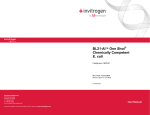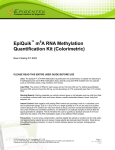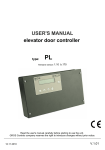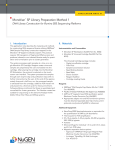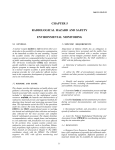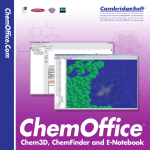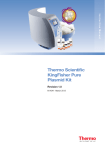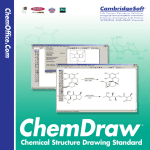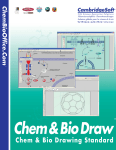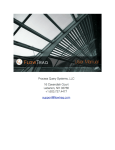Download pBAD-DEST49 Gateway Destination Vector
Transcript
pBAD-DEST49 Gateway® Destination Vector A destination vector for cloning and regulated expression of HP-thioredoxin N-terminal fusions in E. coli Catalog no. 12283-016 Version F 29 December 2010 25-0427 Corporate Headquarters Invitrogen Corporation 1600 Faraday Avenue Carlsbad, CA 92008 T: 1 760 603 7200 F: 1 760 602 6500 E: [email protected] For country-specific contact information visit our web site at www.invitrogen.com User Manual ii Table of Contents Kit Contents and Storage .................................................................................... iv Accessory Products............................................................................................... v Methods.........................................................................................................................1 Overview .................................................................................................................1 Using pBAD-DEST49.............................................................................................4 Expressing the Gene of Interest ...........................................................................7 Analyzing Samples ..............................................................................................10 Appendix.....................................................................................................................13 Recipes ...................................................................................................................13 Regulation by Arabinose.....................................................................................15 Map of pBAD-DEST49 ........................................................................................16 Features of pBAD-DEST49 .................................................................................17 Technical Support ................................................................................................18 Purchaser Notification.........................................................................................20 References..............................................................................................................22 iii Kit Contents and Storage Shipping and Storage pBAD-DEST49 is shipped on wet ice. Upon receipt, store at –20°C. pBAD-DEST49 is guaranteed for six months from the date of shipment when stored at –20oC. Contents iv 6 μg of pBAD-DEST49 vector at 150 ng/μl in TE buffer, pH 8.0 (10 mM Tris-HCl, 1 mM EDTA, pH 8.0). Volume: 40 μl. Accessory Products Additional Products The products below are also available from Invitrogen. For more details visit our Web site at www.invitrogen.com, or contact Technical Support (page 18). Product Quantity Catalog no. Gateway® LR Clonase™ Enzyme Mix One Shot® TOP10 Chemically Competent E. Coli Cells One Shot® TOP10 Electrocompetent E. Coli Cells 20 reactions 10 reactions 20 reactions 10 reactions 20 reactions 10 reactions 11791-019 C4040-10 C4040-03 C4040-50 C4040-52 A10460 20 reactions 25 preps K2400-20 K2100-04 250 units 1000 units 7.5 ml E180-01 E180-02 R180-01 One Shot® ccdB Survival™ 2 T1 Phage-Resistant Cells pENTR Directional TOPO® Cloning Kit PureLink™ HiPure Plasmid Midiprep Kit EKMax™ Enterokinase EK-Away™ Resin Detection of Recombinant Proteins Expression of your recombinant fusion protein can be detected using an antibody to the appropriate epitope. Horseradish peroxidase (HRP) or alkaline phosphatase (AP)conjugated antibodies allow one-step detection using colorimetric or chemiluminescent detection methods. The antibody volume supplied is sufficient for 25 Western blots. Product Quantity Catalog no. Anti-Thio™ Antibody 50 μl R920-25 Epitope Detects His-Patch thioredoxin fusion proteins Note: The exact epitope detected by this antibody has not been mapped. Anti-V5 Antibody 50 μl R960-25 Anti-V5-HRP Antibody Anti-V5-AP Antibody Anti-His (C-term) Antibody Anti-His (C-term)HRP Antibody Anti-His (C-term)AP Antibody 50 μl R961-25 125 μl R962-25 50 μl R930-25 50 μl R931-25 125 μl R932-25 Detects 14 amino acid epitope derived from the P and V proteins of the paramyxovirus, SV5 (Southern et al., 1991) GKPIPNPLLGLDST Detects the C-terminal polyhistidine (6xHis) tag, requires the free carboxyl group for detection (Lindner et al., 1997) HHHHHH-COOH Continued on next page v Accessory Products, Continued Purification of Recombinant Fusion Protein If your gene of interest is in frame with the C-terminal peptide containing the V5 epitope and the polyhistidine (6xHis) tag, you may use Immobilized Metal Affinity Chromatography (IMAC) to purify your recombinant fusion protein. The ProBond™ Purification System or bulk ProBond™ resin are available separately from Invitrogen. For more details on these products, visit our Web site at www.invitrogen.com or contact Technical Support (page 18). Product ProBond™ Nickel-chelating Resin Purification Columns (10 ml polypropylene columns, empty) ProBond™ Purification System Positope™ Control Protein Quantity 50 ml 150 ml 50 each Catalog no. R801-01 R801-15 R640-50 6 purifications 5 μg K850-01 R900-50 A wide range of pre-cast NuPAGE® and Novex® TrisGel Electrophoresis Glycine polyacrylamide gels and electrophoresis apparatuses are available to facilitate separation and visualization of your recombinant fusion protein. For more details on these products, visit our Web site at www.invitrogen.com or contact Technical Support (page 18). vi Introduction Overview Description pBAD-DEST49 is a 6.2 kb vector derived from pBAD/Thio and adapted for use with the Gateway® Technology. pBADDEST49 is designed for regulated expression of N-terminal HP-thioredoxin fusion proteins in E. coli. For a map of pBAD-DEST49, see page 16. Features pBAD-DEST49 contains the following features: • araBAD (pBAD) promoter: provides tight, dosedependent regulation of heterologous gene expression • His-Patch Thioredoxin (HP-thioredoxin) fusion partner for efficient translation of the protein of interest and, in some cases, increased solubility • Two recombination sites, attR1 and attR2, downstream of the HP-thioredoxin gene for recombinational cloning of the gene of interest from an entry clone • Chloramphenicol resistance gene located between the two attR sites for counterselection • The ccdB gene located between the two attR sites for negative selection • The V5 epitope and 6xHis tag for detection and purification (optional) • rrnB transcription terminator for strong transcription termination • The pUC origin for replication and maintenance of the plasmid in E. coli. Note: Although pBAD-DEST49 contains a pUC origin, it acts as a low-copy number plasmid, resulting in lower yields of the vector. • The ampicillin (bla) resistance gene for selection in E. coli • The araC gene for regulation of the araBAD promoter (Lee, 1980; Schleif, 1992) Continued on next page 1 Overview, Continued The Gateway® Technology Gateway® is a universal cloning technology that takes advantage of the site-specific recombination properties of bacteriophage lambda (Landy, 1989) to provide a rapid and highly efficient way to move your gene of interest into multiple vector systems. To express your gene of interest using Gateway® Technology, simply: 1. Clone your gene of interest into a Gateway® entry vector to create an entry clone. 2. Generate an expression clone by performing an LR recombination reaction between the entry clone and a Gateway® destination vector (e.g. pBAD-DEST49). 3. Transform your expression clone into E. coli. Induce expression of your gene of interest using L-arabinose. For more information on the Gateway® Technology, refer to the Gateway® Technology Manual. This manual is available for downloading from our Web site (www.invitrogen.com) or by contacting Technical Support (page 18). Regulation of Expression by L-Arabinose Expression of pBAD is induced in the presence of L-arabinose. In the absence of L-arabinose, only very low levels of transcription are observed from pBAD (Lee, 1980; Lee et al., 1987). Uninduced levels are further repressed by growth in the presence of glucose. Glucose reduces the levels of 3´, 5´-cyclic AMP, lowering expression from the cataboliterepressed pBAD promoter (Miyada et al., 1984). By varying the concentration of L-arabinose, protein expression levels can be optimized to ensure maximum protein expression. In addition, the tight regulation of pBAD by AraC is useful for expression of potentially toxic or essential genes (Carson et al., 1991; Dalbey and Wickner, 1985; Guzman et al., 1992; Kuhn and Wickner, 1985; Russell et al., 1989; San Millan et al., 1989). For additional information on the mechanism of expression and repression of the ara regulon, see page 15. Continued on next page 2 Overview, Continued Thioredoxin The 11.7 kDa thioredoxin protein is found in yeast, plants, and mammals, as well as in bacteria. It was originally isolated from E. coli as a hydrogen donor for ribonuclease reductase (see Holmgren, 1985 for a review) . The gene has been completely sequenced (Wallace and Kushner, 1984), and the protein has been crystallized and its threedimensional structure determined (Katti et al., 1990). When overexpressed in E. coli, thioredoxin is able to accumulate to approximately 40% of the total cellular protein and still remain soluble. When used as a fusion partner, thioredoxin can increase translation efficiency and, in some cases, solubility of eukaryotic proteins expressed in E. coli. Examples of eukaryotic proteins that have been produced as soluble C-terminal fusions to the thioredoxin protein in E. coli (LaVallie et al., 1993) include: • • • • • • • • His-Patch Thioredoxin Murine interleukin-2 Human interleukin-3 Murine interleukin-4 Murine interleukin-5 Human macrophage colony stimulating factor Murine steel factor Murine leukemia inhibitory factor Human bone morphogenetic protein-2 To create a metal binding domain in the thioredoxin protein, the glutamate residue at position 32 and the glutamine residue at position 64 were mutated to create histidine residues. When His-Patch thioredoxin folds, the histidines at positions 32 and 64 interact with a native histidine at position 8 to form a "patch". This histidine patch has high affinity for divalent cations (Lu et al., 1996). His-Patch thioredoxin (HP-thioredoxin) proteins can therefore be purified on metal-chelating resins (e.g. ProBond™, page vi). 3 Methods Using pBAD-DEST49 Important Propagating pBAD-DEST49 The pBAD-DEST49 vector is supplied as a supercoiled plasmid. Although Invitrogen has previously recommended using a linearized destination vector for more efficient recombination, further testing has found that linearization of this vector is not required to obtain optimal results for any downstream application. If you wish to propagate and maintain pBAD-DEST49, we recommend using One Shot® ccdB Survival™ 2 T1 PhageResistant Cells for transformation (page v). The ccdB Survival™ 2 T1 Phage-Resistant E. coli strain is resistant to CcdB effects and can support the propagation of plasmids containing the ccdB gene. Note: Do not use general E. coli cloning strains including TOP10 or DH5α for propagation and maintenance as these strains are sensitive to CcdB effects. Entry Clone To recombine your gene of interest into pBAD-DEST49, you should have an entry clone containing your gene of interest. For your convenience, Invitrogen offers the pENTR Directional TOPO® Cloning Kit (page v) for 5-minute cloning of your gene of interest into an entry vector. For detailed information on constructing an entry clone, refer to the specific entry vector manual. See the next page for factors to consider when designing your entry clone. Specific Features pBAD-DEST49 is designed with the following features to facilitate expression: • Initiation ATG is correctly spaced from the optimized ribosome binding site to ensure optimal translation of HP-thioredoxin fusions • HP-thioredoxin acts as a translation leader to facilitate high-level expression and in some cases, solubility • HP-thioredoxin can be removed after protein purification using enterokinase (e.g. EKMax™, page v). Continued on next page 4 Using pBAD-DEST49, Continued Points to Consider Before Recombining It is very important to have a properly designed entry clone before recombining with pBAD-DEST49. Refer to the table below and the Recombination Region on page 6. If you wish to… Then your gene in the entry clone… clone in frame with HP-thioredoxin must be in frame with the HPthioredoxin gene after recombination. include the V5 epitope and 6xHis tag must not contain a stop codon and must be in frame with the C-terminal tag after recombination. exclude the V5 epitope and 6xHis tag must contain a stop codon. Recombining Your Gene of Interest Each entry clone contains attL sites flanking the gene of interest. Genes in an entry clone are transferred to the destination vector backbone by mixing the DNAs with the Gateway® LR Clonase™ enzyme mix. The resulting recombination reaction is then transformed into E. coli and the expression clone selected. Recombination between the attR sites on the destination vector and the attL sites on the entry clone replaces the ccdB gene and the chloramphenicol (CmR) gene with the gene of interest and results in the formation of attB sites in the expression clone. Follow the instructions in the Gateway® Technology Manual to set up the LR Clonase™ reaction, transform a recA endA E. coli strain (e.g. TOP10 or DH5α) , and select for the expression clone. Resuspending Before you perform the LR Clonase™ reaction, resuspend pBAD-DEST49 pBAD-DEST49 to 50–150 ng/μl in sterile water. Continued on next page 5 Using pBAD-DEST49, Continued Confirming the The ccdB gene mutates at a very low frequency, resulting in a very low number of false positives. True expression clones Expression will be ampicillin-resistant and chloramphenicol-sensitive. Clone Transformants containing a plasmid with a mutated ccdB gene will be both ampicillin- and chloramphenicol-resistant. To check your putative expression clone, test for growth on LB plates containing 30 μg/ml chloramphenicol. A true expression clone will not grow in the presence of chloramphenicol. Recombination The recombination region of the expression clone resulting from pBAD-DEST49 × entry clone is shown below. Region Features of the Recombination Region: • Shaded regions correspond to those DNA sequences transferred from the entry clone into pBAD-DEST49 by recombination. Non-shaded regions are derived from the pBAD-DEST49 vector. • The underlined nucleotides flanking the shaded region correspond to bases 725 and 2408, respectively, of the pBAD-DEST49 vector sequence. His-Patch Thioredoxin 640 gly gln leu lys glu phe leu asp ala asn leu ala gly ser gly ser gly GGT CAG TTG AAA GAG TTC CTC GAC GCT AAC CTG GCC GGC TCT GGA TCC GGT CCA GTC AAC TTT CTC AAG GAG CTG CGA TTG GAC CGG CCG AGA CCT AGG CCA Enterokinase Recognition Site 691 Enterokinase cleavage site 2408 742 725 asp asp asp asp lys leu gly ile ile thr ser leu tyr lys lys ala gly GAT GAC GAT GAC AAG CTG GGA ATT ATC ACA AGT TTG TAC AAA AAA GCA GGC CTA CTG CTA CTG TTC GAC CCT TAA TAG TGT TCA AAG ATG TTT TTT CGT CCG attB1 ... ... ... ... pro ala phe leu tyr lys val val ile lys leu glu TNN --- --- NAC CCA GCT TTC TTG TAC AAA GTG GTG ATC AAG CTT GAA GENE ANN ----- NTG GGT CGA AAG AAC ATG TTT CAC CAC TAG TTC GAA CTT attB2 V5 epitope 2436 gly lys pro ile pro asn pro leu leu gly leu asp ser thr arg thr GGT AAG CCT ATC CCT AAC CCT CTC CTC GGT CTC GAT TCT ACG CGT ACC CCA TTG GGA TAG GGA TTG GGA GAG GAG GGT GAG CTA AGA TGC GCA TGG 2484 gly his his his his his his *** GGT CAT CAT CAC CAT CAC CAT TGA GTT TAA ACG GTC TCC AGC TTG GCT CCA TTG CCA GTA GTA GTG GTA GTG GTA ACT CAA ATT TGC CAG AGG TCG 6xHis tag 6 Expressing the Gene of Interest Introduction Once you have selected your expression clone, you are ready to transform it into E. coli and test for expression of your gene. Since each recombinant protein has different characteristics that may affect optimal expression, it is helpful to vary the L-arabinose concentration and/or run a time course of expression to determine the best conditions for optimal expression of your particular protein. Plasmid Preparation You may prepare plasmid DNA using your method of choice. We recommend using the PureLink™ HiPure Plasmid Midiprep Kit (page v) for isolation of pure plasmid DNA. Note that since you are purifying a vector that acts as a lowcopy number plasmid, you may need to increase the amount of bacterial culture that you use to prepare your plasmid construct. E. coli Strain We recommend that you transform your construct into an E. coli strain that is deficient for the ara operon. TOP10 competent cells are deleted for araBADC and are available from Invitrogen as chemically competent or electrocompetent cells (page v). L-Arabinose Prepare a 20% solution of L-arabinose in deionized water and filter sterilize. Store at room temperature. To determine the optimal concentration for expression of your particular protein, see the next page. D-arabinose will not induce expression and should not be used. Note: L-arabinose can be ordered from Sigma (Catalog no. A3256). Continued on next page 7 Expressing the Gene of Interest, Continued Basic Strategy Once you have clones that you wish to characterize, we recommend the following strategy to determine the optimal expression level. 1. Pilot Expression: In this expression experiment you will vary the amount of arabinose over a 10,000-fold range (0.00002% to 0.2%) to determine the approximate amount of arabinose needed for maximum expression of your protein. (See next page for protocol). 2. To optimize expression of your protein, you may wish to try arabinose concentrations spanning the amount determined in Step 1, or you may perform a time course. Note: If your protein is insoluble, remember to analyze the supernatant and the pellet of lysed cells for expression of soluble protein (see page 10). Materials Needed Be sure to have the following solutions and equipment on hand before starting the experiment: • SOB or LB medium containing 50–100 μg/ml ampicillin (see pages 13-14 for recipes) • 37°C shaking incubator • 20% L-arabinose • 37°C heat block or water bath • 42°C water bath • Liquid nitrogen • 1X and 2X SDS-PAGE sample buffer • Reagents and apparatus for SDS-PAGE gel • Boiling water bath • Lysis Buffer (see page 14 for recipe) • Sterile water Continued on next page 8 Expressing the Gene of Interest, Continued Pilot Expression In addition to testing your transformants, we recommend that you include cells without a vector as a negative control. 1. For each transformant or control, inoculate 2 ml of SOB or LB medium containing 50–100 μg/ml ampicillin with a single recombinant E. coli colony. 2. Grow cells overnight on a 37°C shaking incubator at 225–250 rpm. The cells should have an optical density at 600 (OD600) of 1–2 3. Label five tubes 1 through 5 and add 10 ml of SOB or LB medium containing 50–100 μg/ml ampicillin. 4. Inoculate each tube with 0.1 ml of the overnight culture. 5. Grow the cultures in the tubes on a 37°C shaking incubator (use vigorous shaking) Grow cells to an OD600 of ~0.5 (the cells should be in mid-log phase). 6. While the cells are growing, prepare four 10-fold serial dilutions of 20% L-arabinose with sterile water using aseptic technique (e.g. 2%, 0.2%, 0.02%, and 0.002%). 7. Take a 1 ml aliquot of grown cells from each tube, and place each aliquot in separate microcentrifuge tubes. Centrifuge at maximum speed in a microcentrifuge for 30 seconds, and aspirate the supernatant. 8. Freeze the cell pellet at –20°C. This is the zero time pointsample. 9. Using the solutions prepared in Step 6, add the following volumes of L-arabinose to the five 9 ml cultures. Note: It is only necessary to test the highest concentration of L-arabinose. Tube 1 2 3 4 5 Stock Solution Volume (ml) 0.002% 0.09 0.02% 0.09 0.2% 0.09 2% 0.09 20% 0.09 Final Concentration 0.00002% 0.0002% 0.002% 0.02% 0.2% 10. Grow at 37°C with shaking for 4 hours. 11. Take 1 ml samples at 4 hours and treat samples as in Steps 7 and 8. You will have a total of 10 samples for each transformant and two samples for the negative control. 12. Proceed to Analyzing Samples, next page. 9 Analyzing Samples Preparation of Samples Before starting, prepare SDS-PAGE gels or use one of the pre-cast polyacrylamide gels available from Invitrogen (page vi) to analyze all the samples you collected. Note: If you wish to analyze your samples for soluble protein, see the section below. 1. When all the samples have been collected from Steps 8 and 11 in the Pilot Expression, resuspend each pellet in 100 μl of 1X SDS-PAGE sample buffer. 2. Heat for 5 minutes at 70°C and centrifuge briefly. 3. Load 5–10 μl of each sample on an SDS-PAGE gel and electrophorese. Save your samples by storing at –20°C. Preparing Samples for Soluble/ Insoluble Protein 1. Thaw and resuspend each pellet in 500 μl of Lysis Buffer (see page 14 for recipe). 2. Freeze sample in dry ice or liquid nitrogen and then thaw at 42°C. Repeat 2 to 3 times. Note: To facilitate lysis, you may need to add lysozyme or sonicate the cells. 3. Centrifuge samples at maximum speed in a microcentrifuge for 1 minute at +4°C to pellet insoluble proteins. Transfer supernatant to a fresh tube and store on ice. 4. Mix together equivalent amounts of supernatant and 2X SDS-PAGE sample buffer and boil for 5 minutes. 5. Add 500 μl of 1X SDS-PAGE sample buffer to the pellets from Step 3 and boil 5 minutes. 6. Load 10 μl of the supernatant sample and 5μl of the pellet sample onto an SDS-PAGE gel and electrophorese. Continued on next page 10 Analyzing Samples, Continued Analyzing Samples To determine the success of your expression experiment, you may want to perform the following types of analyses: 1. Stain the polyacrylamide gel with Coomassie blue and look for a band of increasing intensity in the expected size range for the recombinant protein. Use the uninduced culture as a negative control. 2. Perform a Western blot to confirm that the overexpressed band is your desired protein (see below). 3. Determine the approximate arabinose concentration for maximum expression. Detection of Recombinant Fusion Proteins To detect expression of your recombinant fusion protein by Western blot analysis, you may use antibodies against the appropriate epitope ( page v) or an antibody to your protein of interest. In addition, the Positope™ Control Protein (page vi) is available from Invitrogen for use as a positive control for detection of fusion proteins containing a thioredoxin, V5, or C-terminal 6xHis epitope. Expression of your protein with the N-terminal HP-thioredoxin peptide and the C-terminal tag will increase the size of your protein by approximately 14 kDa and 4 kDa, respectively. Continued on next page 11 Analyzing Samples, Continued Optimization of Expression Once you have detected expression of your protein of interest, you may wish to perform experiments to further optimize expression. Use the Pilot Expression protocol (page 9), but vary the L-arabinose concentration over a smaller range. For example, if you obtained the best expression at 0.002%, try 0.0004%, 0.0008%, 0.001%, 0.004%, and 0.008%. You may also perform a time course of induction to determine if varying the time increases expression. Take time points every hour, over a 5 to 6 hour period. If your protein is insoluble, you may wish to analyze the supernatant and pellet of lysed cells when you vary the L-arabinose concentration (see Preparing Samples for Soluble/Insoluble Protein, page 10). Remember to store your cell lysates at –20°C. Expression of Toxic Proteins To ensure low levels of expression, you may want to utilize glucose to further repress the araBAD promoter. Follow the Pilot Expression protocol (page 9) using SOB or LB containing 50–100 μg/ml ampicillin plus glucose at all steps (see pages 13-14 for recipes). Purification of Recombinant Fusion Proteins The presence of the C-terminal polyhistidine (6xHis) tag in your recombinant fusion protein allows use of a metalchelating resin such as ProBond™ (page vi) to purify your fusion protein. Note: Other metal-chelating resins and purification methods are suitable. Removal of the N-terminal Leader by Enterokinase The enterokinase (EK) recognition site can be used to remove the N-terminal leader from your recombinant fusion protein after purification. Note that after digestion with enterokinase, there will be twelve vector-encoded amino acids remaining at the N-terminus of the protein (see diagram on page 6). A recombinant preparation of the catalytic subunit of bovine enterokinase (EKMax™) is available from Invitrogen (see page v). 12 Appendix Recipes LB (LuriaBertani) Medium and Plates 1.0% Tryptone 0.5% Yeast Extract 1.0% NaCl 0.1% glucose (optional) pH 7.0 1. Dissolve 10 g tryptone, 5 g yeast extract, and 10 g NaCl in 950 ml deionized water. 2. Adjust solution to pH 7.0 with NaOH and add deionized water to 1 liter. 3. Autoclave on liquid cycle for 20 minutes at 15 psi. Allow solution to cool to 55°C. Add antibiotic if needed. 4. Add 5 ml of a 20% sterile glucose solution (optional). 5. Store at room temperature or at +4°C. LB agar plates 1. Prepare LB medium as above, but add 15 g/L agar before autoclaving. 2. Autoclave on liquid cycle for 20 minutes at 15 psi. 3. After autoclaving, cool to ~55°C. Add antibiotic if needed. 4. Add 5 ml of a 20% sterile glucose solution (optional). 5. Pour into 10 cm plates and let harden. Invert plates and store at +4°C in the dark. Continued on next page 13 Recipes, Continued SOB Medium 2% Tryptone 0.5% Yeast Extract 0.05% NaCl 2.5 mM KCl 10 mM MgCl2 0.1% glucose (optional) 1. Dissolve 20 g tryptone, 5 g yeast extract, and 0.5 g NaCl in 950 ml deionized water. 2. Make a 250 mM KCl solution by dissolving 1.86 g of KCl in 100 ml of deionized water. Add 10 ml of this stock KCl solution to the solution in Step 1. 3. Adjust pH to 7.5 with 5 M NaOH and add deionized water to 1 liter. 4. Autoclave this solution and cool to ~55°C. Add 10 ml of sterile 1 M MgCl2. Add antibiotic if needed. 5. Add 5 ml of a 20% sterile glucose solution (optional). 6. Store at +4°C. Medium is stable for only 1–2 weeks. Lysis Buffer 50 mM potassium phosphate, pH 7.8 400 mM NaCl 100 mM KCl 10% glycerol 0.5% Triton X-100 10 mM imidazole 1. Prepare 1 M stock solutions of KH2PO4 and K2HPO4. 2. For 100 ml, dissolve the following reagents in 90 ml of deionized water: 0.3 ml KH2PO4 4.7 ml K2HPO4 2.3 g NaCl 0.75 g KCl 10 ml glycerol 0.5 ml Triton X-100 68 mg imidazole 3. Mix thoroughly and adjust pH to 7.8 with HCl. Bring the volume to 100 ml. 4. Store at +4°C. 14 Regulation by L-Arabinose Regulation of the PBAD Promoter The araBAD promoter used in pBAD-DEST49 is both positively and negatively regulated by the product of the araC gene (Ogden et al., 1980; Schleif, 1992). The AraC protein is a transcriptional regulator that forms a complex with L-arabinose. In the absence of L-arabinose the AraC dimer contacts the O2 and I1 half sites of the araBAD operon, forming a 210 bp DNA loop (see figure below). For maximum transcriptional activation two events are required. • L-arabinose binds to AraC and causes the protein to release the O2 site and bind the I2 site, which is adjacent to the I1 site. This releases the DNA loop and allows transcription to begin. • The cAMP activator protein (CAP)-cAMP complex binds to the DNA and stimulates binding of AraC to I1 and I2. O2 C AraC dimer N N Pc C No transcription I1 I2 pBAD + arabinose N N Transcription Pc Glucose Repression CAP C I1 C I2 pBAD Glucose represses basal expression levels by lowering cAMP levels which in turn decrease the binding of CAP. As cAMP levels are lowered, transcriptional activation is decreased. Add glucose to the culture medium to repress basal expression levels. 15 Map of pBAD-DEST49 Map of pBADDEST49 The map below shows the elements of pBAD-DEST49. DNA from the entry clone replaces the region between bases 725 and 2408. The complete sequence of pBAD-DEST49 is available for downloading from our Web site (www.invitrogen.com) or by contacting Technical Support (page 18). CmR attR2 V5 6xHis Stop ccdB A AD m lin cil pi PB HP-thioredoxin EK attR1 pBAD-DEST49 6160 bp ar a C Features of pBAD-DEST49 6160 nucleotides pUC or i Arabinose O2 operator: bases 4-19 Arabinose O1 operator: bases 161-182 CAP binding site: bases 203-216 Arabinose I1 and I2 region: bases 213-251 Arabinose minimal promoter: bases 248-276 RBS: bases 329-332 His-Patch Thioredoxin: bases 346-674 Enterokinase recognition site: bases 691-705 attR1 recombination site: bases 718-842 Chloramphenicol resistance gene: bases 951-1610 ccdB gene: bases 1952-2257 attR2 recombination site: bases 2298-2422 V5 epitope: bases 2436-2477 6xHis tag: bases 2487-2507 rrnB transcription termination region: bases 2610-2767 bla promoter: bases 2948-3046 Ampicillin resistance gene (bla): bases 3047-3907 pUC origin: bases 4052-4725 araC gene: bases 5256-6134 (complementary strand) Continued on next page 16 Features of pBAD-DEST49 Features of pBAD-DEST49 pBAD-DEST49 (6160 bp) contains the following elements. Features have been functionally tested. Feature Benefit araBAD promoter (PBAD) Provides tight, dose-dependent regulation of heterologous gene expression (Guzman et al., 1995) O2 region Binding site of AraC that represses transcription from PBAD O1 region Binding site of AraC that represses transcription of the araC promoter (PC) (transcribed on the opposite strand) CAP binding site Site where CAP (cAMP binding protein) binds to activate transcription from PBAD and PC I2 and I1 regions Binding sites of AraC that activate transcription from PBAD Ribosome binding site Increases efficiency of recombinant fusion protein expression HP-thioredoxin Provides a highly efficient fusion partner for translation of the fusion protein Enterokinase recognition site Allows removal of the N-terminal tag from the recombinant fusion protein attR1 and attR2 sites Allows recombinational cloning of the gene of interest from an entry clone Chloramphenicol resistance gene Allows counterselection of expression clones ccdB gene Allows negative selection of expression clones V5 epitope Allows detection of the recombinant protein by the Anti-V5 antibodies (Southern et al., 1991) C-terminal polyhistidine tag Allows purification of the recombinant protein on metal-chelating resin such as ProBond™ Allows detection of the recombinant protein by the Anti-His (C-term) antibodies (Lindner et al., 1997) rrnB transcription termination region Strong transcription termination region Ampicillin resistance gene Allows selection of the plasmid in E. coli pUC origin (see note on page 1) Allows low-copy replication and growth in E. coli araC gene Encodes the regulatory protein for tight regulation of the PBAD promoter (Lee, 1980; Schleif, 1992) 17 Technical Support Web Resources Contact Us Visit the Invitrogen website at www.invitrogen.com for: • Technical resources including manuals, vector maps and sequences, application notes, MSDSs, FAQs, formulations, citations, handbooks, etc. • Complete technical support contact information. • Access to the Invitrogen Online Catalog. • Additional product information and special offers. For more information or technical assistance, call, write, fax, or email. Additional international offices are listed on our website (www.invitrogen.com). Corporate Headquarters Japanese Headquarters: European Headquarters: Invitrogen Corporation 5791 Van Allen Way Carlsbad, CA 92008 USA Invitrogen Japan LOOP-X Bldg. 6F Invitrogen Ltd Inchinnan Business Park 3 Fountain Drive Paisley PA4 9RF, UK 3-9-15, Kaigan Tel: 1 760 603 7200 Minato-ku, Tokyo 108-0022 Tel (Toll Free): 1 800 955 6288 Fax: 1 760 602 6500 Tel: 81 3 5730 6509 Fax: 81 3 5730 6519 E-mail: [email protected] E-mail: [email protected] Tel: +44 (0) 141 814 6100 Fax: +44 (0) 141 814 6117 E-mail: [email protected] MSDS MSDSs (Material Safety Data Sheets) are available on our website at www.invitrogen.com/msds. Certificate of Analysis The Certificate of Analysis (CofA) provides detailed quality control information for each product. CofAs are available on our website at www.invitrogen.com/support, and are searchable by product lot number, which is printed on each box. Continued on next page 18 Technical Support, Continued Limited Warranty Invitrogen is committed to providing our customers with high-quality goods and services. Our goal is to ensure that every customer is 100% satisfied with our products and our service. If you should have any questions or concerns about an Invitrogen product or service, contact our Technical Support Representatives. Invitrogen warrants that all of its products will perform according to the specifications stated on the certificate of analysis. The company will replace, free of charge, any product that does not meet those specifications. This warranty limits Invitrogen Corporation’s liability only to the cost of the product. No warranty is granted for products beyond their listed expiration date. No warranty is applicable unless all product components are stored in accordance with instructions. Invitrogen reserves the right to select the method(s) used to analyze a product unless Invitrogen agrees to a specified method in writing prior to acceptance of the order. Invitrogen makes every effort to ensure the accuracy of its publications, but realizes that the occasional typographical or other error is inevitable. Therefore Invitrogen makes no warranty of any kind regarding the contents of any publications or documentation. If you discover an error in any of our publications, report it to our Technical Support Representatives. Invitrogen assumes no responsibility or liability for any special, incidental, indirect or consequential loss or damage whatsoever. The above limited warranty is sole and exclusive. No other warranty is made, whether expressed or implied, including any warranty of merchantability or fitness for a particular purpose. 19 Purchaser Notification Limited Use Label License No. 19: Gateway® Cloning Products The purchase of this product conveys to the buyer the non-transferable right to use the purchased amount of the product and components of the product in research conducted by the buyer (whether the buyer is an academic or for profit entity). The purchase of this product does not convey a license under any method claims in the foregoing patents or patent applications, or to use this product with any recombination sites other than those purchased from Invitrogen Corporation or its authorized distributor. The right to use methods claimed in the foregoing patents or patent applications with this product for research purposes only can only be acquired by the use of ClonaseTM purchased from Invitrogen Corporation or its authorized distributors. The buyer cannot modify the recombination sequence(s) contained in this product for any purpose. The buyer cannot sell or otherwise transfer (a) this product, (b) its components, or (c) materials made by the employment of this product or its components to a third party or otherwise use this product or its components or materials made by the employment of this product or its components for Commercial Purposes. The buyer may transfer information or materials made through the employment of this product to a scientific collaborator, provided that such transfer is not for any Commercial Purpose, and that such collaborator agrees in writing (a) not to transfer such materials to any third party, and (b) to use such transferred materials and/or information solely for research and not for Commercial Purposes. Notwithstanding the preceding, any buyer who is employed in an academic or government institution may transfer materials made with this product to a third party who has a license from Invitrogen under the patents identified above to distribute such materials. Transfer of such materials and/or information to collaborators does not convey rights to practice any methods claimed in the foregoing patents or patent applications. Commercial Purposes means any activity by a party for consideration and may include, but is not limited to: (1) use of the product or its components in manufacturing; (2) use of the product or its components to provide a service, information, or data; (3) use of the product or its components for therapeutic, diagnostic or prophylactic purposes; or (4) resale of the product or its components, whether or not such product or its components are resold for use in research. Invitrogen Corporation will not assert a claim against the buyer of infringement of the above patents based upon the manufacture, use or sale of a therapeutic, clinical diagnostic, vaccine or prophylactic product developed in research by the buyer in which this product or its components was employed, provided that none of (i) this product, (ii) any of its components, or (iii) a method claim of the foregoing patents, was used in the manufacture of such product. Invitrogen Corporation will not assert a claim against the buyer of infringement of the above patents based upon the use of this product to manufacture a protein for sale, provided that no method claim in the above patents was used in the manufacture of such protein. If the purchaser is not willing to accept the limitations of this limited use statement, Invitrogen is willing to accept return of the product with a full refund. For information on purchasing a license to use this product for purposes other than those permitted above, contact Licensing Department, Invitrogen Corporation, 5791 Van Allen Way, Carlsbad, California 92008. Phone (760) 603-7200. Continued on next page 20 Purchaser Notification, Continued Limited Use Label License No. 22: Vectors and Clones Encoding Histidine Hexamer This product is licensed under U.S. and foreign patents from Hoffmann-LaRoche, Inc., Nutley, NJ and/or HoffmannLaRoche Ltd., Basel, Switzerland and is provided only for use in research. Information about licenses for commercial use is available from QIAGEN GmbH, Max-Volmer-Str. 4, D-40724 Hilden, Germany. Limited Use Label License No. 29: ThioFusion™ Expression System The ThioFusion™ Expression System is licensed under U.S. patents from Genetics Institute, Inc. for research use only. Licenses for commercial manufacture or use may be obtained directly from Genetics Institute, Inc., 87 Cambridgepark Drive, Cambridge, MA 02140. 21 References Carson, M. J., Barondess, J. J., and Beckwith, J. (1991). The FtsQ Protein of Escherichia coli: Membrane Topology, Abundance, and Cell Division Phenotypes Due to Overproduction and Insertion Mutations. J. Bacteriol. 173, 2187-2195. Dalbey, R. E., and Wickner, W. (1985). Leader Peptidase Catalyzes the Release of Exported Proteins from the Outer Surface of the Escherichia coli Plasma Membrane. J. Biol. Chem. 260, 15925-15931. Guzman, L.-M., Barondess, J. J., and Beckwith, J. (1992). FtsL, an Essential Cytoplasmic Membrane Protein Involved in Cell Division in Escherichia coli. J. Bacteriol. 174, 7716-7728. Holmgren, A. (1985). Thioredoxin. Ann. Rev. Biochem. 54, 237-271. Katti, S. K., LeMaster, D. M., and Eklund, H. (1990). Crystal Structure of Thioredoxin from E. coli at 1.68 Angstroms Resolution. J. Mol. Biol. 212, 167-184. Kuhn, A., and Wickner, W. (1985). Isolation of Mutants in M13 Coat Protein That Affect its Synthesis, Processing and Assembly into Phage. J. Biol. Chem. 260, 15907-15913. Landy, A. (1989). Dynamic, Structural, and Regulatory Aspects of Lambda Sitespecific Recombination. Annu. Rev. Biochem. 58, 913-949. LaVallie, E. R., DiBlasio, E. A., Kovacic, S., Grant, K. L., Schendel, P. F., and McCoy, J. M. (1993). A Thioredoxin Gene Fusion Expression System That Circumvents Inclusion Body Formation in the E. coli Cytoplasm. Bio/Technology 11, 187-193. Lee, N. (1980) Molecular Aspects of ara Regulation. In The Operon, J. H. Miller and W. S. Reznikoff, eds. (Cold Spring Harbor, N.Y.: Cold Spring Harbor Laboratory), pp. 389-410. Lee, N., Francklyn, C., and Hamilton, E. P. (1987). Arabinose-Induced Binding of AraC Protein to araI2 Activates the araBAD Operon Promoter. Proc. Natl. Acad. Sci. USA 84, 8814-8818. Lindner, P., Bauer, K., Krebber, A., Nieba, L., Kremmer, E., Krebber, C., Honegger, A., Klinger, B., Mocikat, R., and Pluckthun, A. (1997). Specific Detection of His-tagged Proteins With Recombinant Anti-His Tag scFvPhosphatase or scFv-Phage Fusions. BioTechniques 22, 140-149. continued on next page 22 References, Continued Lu, Z., DiBlasio-Smith, E. A., Grant, K. L., Warne, N. W., LaVallie, E. R., CollinsRacie, L. A., Follettie, M. T., Williamson, M. J., and McCoy, J. M. (1996). Histidine Patch Thioredoxins. J. Biol. Chem. 271, 5059-5065. Miyada, C. G., Stoltzfus, L., and Wilcox, G. (1984). Regulation of the araC Gene of Escherichia coli: Catabolite Repression, Autoregulation, and Effect on araBAD Expression. Proc. Natl. Acad. Sci. USA 81, 4120-4124. Ogden, S., Haggerty, D., Stoner, C. M., Kolodrubetz, D., and Schleif, R. (1980). The Escherichia coli L-Arabinose Operon: Binding Sites of the Regulatory Proteins and a Mechanism of Positive and Negative Regulation. Proc. Natl. Acad. Sci. USA 77, 3346-3350. Russell, C. B., Stewart, R. C., and Dahlquist, F. W. (1989). Control of Transducer Methylation Levels in Escherichia coli: Investigation of Components Essential for Modulation of Methylation and Demethylation Reactions. J. Bacteriol. 171, 36093618. San Millan, J. L., Boyd, D., Dalbey, R., Wickner, W., and Beckwith, J. (1989). Use of phoA Fusions to Study the Topology of the Escherichia coli Inner Membrane Protein Leader Peptidase. J. Bacteriol. 171, 5536-5541. Schleif, R. S. (1992). DNA Looping. Ann. Rev. Biochem. 61, 199-223. Southern, J. A., Young, D. F., Heaney, F., Baumgartner, W., and Randall, R. E. (1991). Identification of an Epitope on the P and V Proteins of Simian Virus 5 That Distinguishes Between Two Isolates with Different Biological Characteristics. J. Gen. Virol. 72, 1551-1557. Wallace, B. J., and Kushner, S. R. (1984). Genetic and Physical Analysis of the Thioredoxin (trxA) Gene of Escherichia coli K-12. Gene 32, 399-408. © 2002–2008, 2010 Invitrogen Corporation. All rights reserved. 23 Corporate Headquarters Invitrogen Corporation 5791 Van Allen Way Carlsbad, CA 92008 T: 1 760 603 7200 F: 1 760 602 6500 E: [email protected] For country-specific contact information, visit our web site at www.invitrogen.com User Manual































